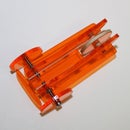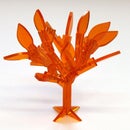Introduction: No Glue Laser Cut Whistle
There are already a number of laser cut whistles, flutes and pipes on the net.
For example this one on Thingiverse was a source of inspiration for this simple project.
My version just shows a possibility to make one without the need to glue the parts together. As it is part of my Laser Cut Advent Calendar series I wanted to use only rubber bands and bolts, next to the laser cut parts. In this case I kept to rubber bands only. Also I wanted to make the design tolerant to thickness variation, as acrylic sheet is documented to vary up to +-15% of it’s nominal thickness. The result is actually very indifferent to the sheet thickness, it will probably work from 1 mm to 5 mm and upwards.
The result is a whistle that sounds like the steam whistle on classic train. A sound recording is attached as .m4a and .mp3.
This Instructable is one of the long due Instructables based on the projects I did when I was Artist in Residence at Instructables/Pier 9 in July 2013.
Step 1: Materials, Parts and Tools:
The rubber bands: I used three rubber bands 1” x 1/8 “. You can use other size, as long as you double them up to keep the parts tight to each other.
Sheet material: I used 3mm thick transparent amber acrylic sheet as in the rest of the Laser Cut Advent Calendar series, but you can use a range of thicknesses in about any material that is safe to laser cut and put in your mouth afterwards. Personally on that last topic, I’m a bit doubtful about plywood and its scorched edges.
The laser cutter: Obviously you will need access to a laser cutter or an online laser cutting service. I used a 120W Epilog laser cutter in the workshop at Pier 9, were the Instructables HQ is.
The design: it was made in Inkscape and included here in pdf and svg format in the zip-file.
Attachments
Step 2: Building:
On the 120W Epilog, the parts were cut with speed 50% and power 70%.
Stack the parts as shown in the pictures. Keep them together with the three rubber bands. The bands need to be doubled up to hold the parts firmly together. If the seams are not airtight, you won’t get a tone out of it.
I did a short experiment adding holes to make a high pitch flute, but that gave a terrible sound. This would need further study, making it longer bringing the pitch down, taking even more care in getting the assembly airtight, and tuning the position of the holes to get actual notes. Probably the ‘lip’ needs optimising too.







